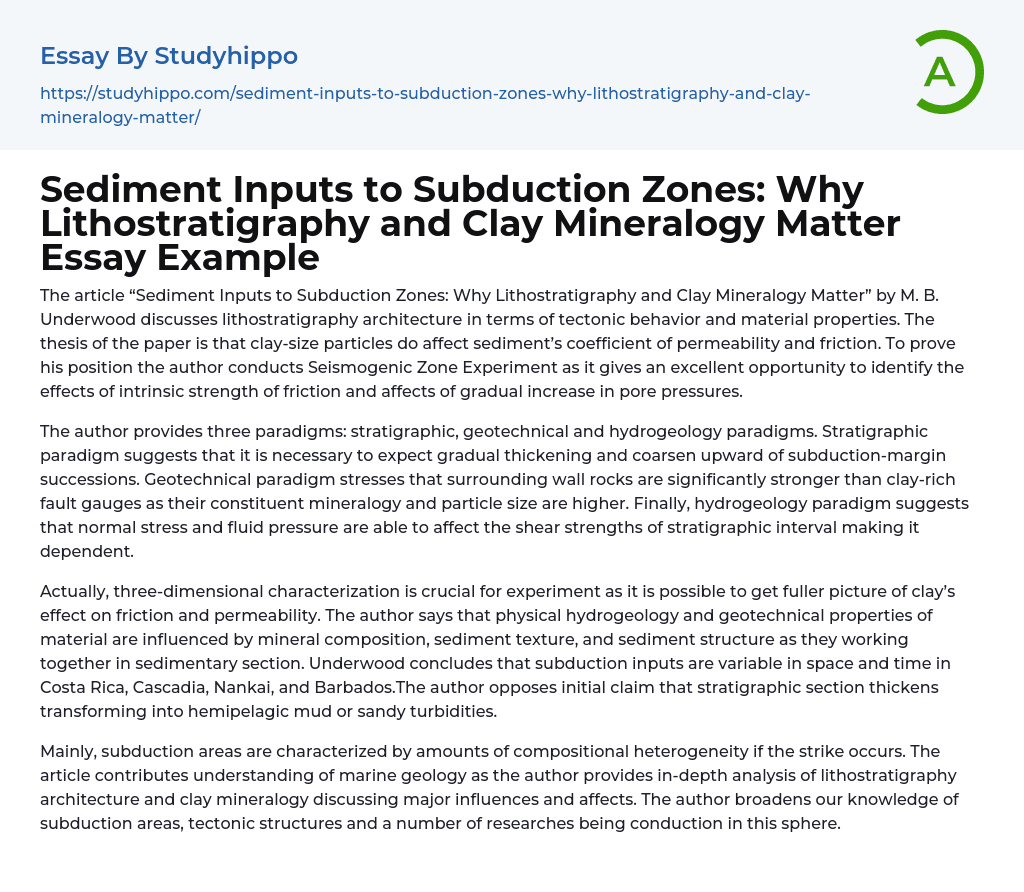

Sediment Inputs to Subduction Zones: Why Lithostratigraphy and Clay Mineralogy Matter Essay Example
In the article "Sediment Inputs to Subduction Zones: Why Lithostratigraphy and Clay Mineralogy Matter", M. B. Underwood explores lithostratigraphy architecture and its relationship with tectonic behavior and material properties. The main argument of the article is that the size of clay particles affects sediment's coefficient of permeability and friction. To support this claim, the author conducts a Seismogenic Zone Experiment that provides insight into the effects of intrinsic strength of friction and gradual increases in pore pressure.
In the text, the author introduces three paradigms: stratigraphic, geotechnical and hydrogeology. According to the stratigraphic paradigm, subduction-margin successions can be anticipated to gradually thicken and become coarser as they go upward. According to the geotechnical paradigm, wall rocks bordering clay-rich fault gauges have a higher constituent mineralogy and particle size, and thus possess significantly greater strength. Lastly, the hydrogeology paradigm postulate
...s that shear strength of the stratigraphic interval can be impacted by normal stress and fluid pressure, rendering it reliant on these constituents.
The author emphasizes the importance of three-dimensional characterization in experiments as it provides a more comprehensive understanding of the impact of clay on friction and permeability. The physical hydrogeology and geotechnical properties of sedimentary materials are influenced by a combination of mineral composition, sediment texture, and sediment structure. Underwood's research indicates that subduction inputs vary in both space and time across several locations including Costa Rica, Cascadia, Nankai, and Barbados. The author also disagrees with the original assertion that stratigraphic sections transform into hemipelagic mud or sandy turbidities.
Mainly, if a strike occurs in subduction areas, they exhibit significant compositional heterogeneity. This article offers a comprehensive analysis of lithostratigraphy architecture and clay mineralogy an
their major influences and effects, contributing to the understanding of marine geology. The author expands our knowledge of subduction areas, tectonic structures, and various ongoing research in this field.
- Oxygen essays
- Atmosphere essays
- Coral Reef essays
- Desert essays
- Earth essays
- Ocean essays
- Lake essays
- Sea essays
- Biodiversity essays
- Natural Environment essays
- Forest essays
- Soil essays
- Water essays
- Rainbow essays
- Ecosystem essays
- Volcano essays
- Wind essays
- Forestry essays
- Bottled Water essays
- Experiment essays
- Explorer essays
- Hypothesis essays
- Observation essays
- Qualitative Research essays
- Research Methods essays
- Theory essays
- Agriculture essays
- Albert einstein essays
- Animals essays
- Archaeology essays
- Bear essays
- Biology essays
- Birds essays
- Butterfly essays
- Cat essays
- Charles Darwin essays
- Chemistry essays
- Dinosaur essays
- Discovery essays
- Dolphin essays
- Elephant essays
- Eli Whitney essays
- Environmental Science essays
- Evolution essays
- Fish essays
- Genetics essays
- Horse essays
- Human Evolution essays
- Isaac Newton essays
- Journal essays



